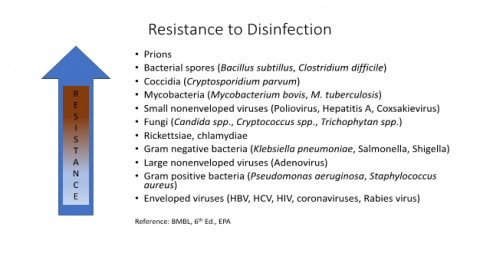Disinfectants are used to eliminate infectious or pathogenic agents and other potentially infectious materials (OPIM) in the laboratory. Determining the most effective disinfection procedure and selecting the most appropriate disinfectant is dependent on the specific microbial agent(s) known or suspected to be present, as each chemical compound has a selective germicidal activity. No liquid disinfectant is equally useful or effective under all conditions and for all viable agents. Enveloped viruses are generally susceptible to most disinfectants, while bacterial spores are much more resistant to disinfection. Prions are the most resistant to inactivation and require specific procedures that are addressed in the Biosafety Manual, p. 74.

Note: There may be exceptions to this list. Resistance to disinfectants may be dependent on temperature, concentration, organic matter load, etc.
Some common disinfectants are listed below. For more detailed information regarding disinfection, decontamination and sterilization see the Biosafety Manual, p. 64-79.
Alcohols: Alcohols (ethyl and isopropyl) are good disinfectants at concentrations of 70-80% in water (volume/volume) for general disinfection, when the appropriate contact time can be achieved. Use of concentrations outside the 70-80% is generally not recommended. Alcohol denatures protein, effectively inactivating the agent. The denaturation of protein is achieved more effectively at 70-80% alcohol. Additionally, 70-80% alcohol evaporates more slowly than 85-100% alcohol, thus increasing the contact time of the disinfectant. However, because of the rapid evaporation, EHS does not recommend alcohol solutions as the sole means of surface disinfection, particularly following a spill of a biological agent.
Safety Note: Alcohols are flammable; never use near a flame or ignition source.
Chlorine: Chlorine is a broad-spectrum germicide and is effective against bacteria, viruses, mycobacteria and fungal spores. It is the recommended general all-purpose laboratory disinfectant. Sodium hypochlorite (NaOCL) is an aqueous solution and is sold as bleach. Household commercial bleach contains 5.25 percent available chlorine; solutions of 10 percent or 20 percent will yield concentrations of 5,000 ppm and 10,000 ppm available chlorine, respectively. The activity of chlorine, especially as bleach, is reduced in the presence of protein.
Safety Note: NEVER mix bleach with acids; the mixture will cause the release of a highly toxic chlorine gas. NEVER mix bleach with ammonia; the mixture will cause the release of highly toxic chloramine gas. Chlorine is also highly alkaline and is corrosive to metal. Always rinse metal surfaces with water or 70% ethanol after disinfecting with a bleach solution.